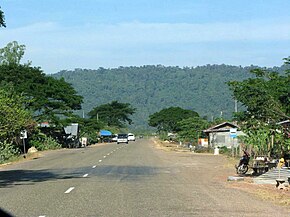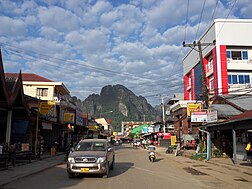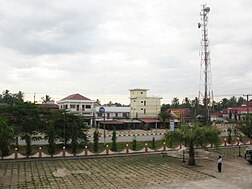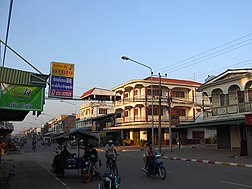
Evidence of modern human presence in the northern and central highlands of Indochina, which constitute the territories of the modern Laotian nation-state, dates back to the Lower Paleolithic. These earliest human migrants are Australo-Melanesians—associated with the Hoabinhian culture—and have populated the highlands and the interior, less accessible regions of Laos and all of Southeast Asia to this day. The subsequent Austroasiatic and Austronesian marine migration waves affected landlocked Laos only marginally, and direct Chinese and Indian cultural contact had a greater impact on the country.
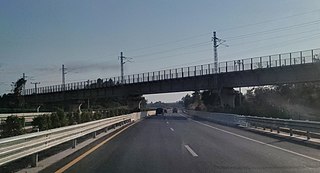
This article concerns the systems of transportation in Laos. Laos is a country in Asia, which possesses a number of modern transportation systems, including several highways and a number of airports. As a landlocked country, Laos possesses no ports or harbours on the sea, and the difficulty of navigation on the Mekong means that this is also not a significant transport route.

Luang Phabang, or Louangphabang, commonly transliterated into Western languages from the pre-1975 Lao spelling ຫຼວງພຣະບາງ as Luang Prabang, literally meaning "Royal Buddha Image", is a city in north central Laos, consisting of 58 adjacent villages, of which 33 comprise the UNESCO Town of Luang Prabang World Heritage Site. It was listed in 1995 for unique and "remarkably" well preserved architectural, religious and cultural heritage, a blend of the rural and urban developments over several centuries, including the French colonial influences during the 19th and 20th centuries.

Vang Vieng is a town in the Vientiane Province in Laos. It is popular with tourists, specifically backpackers, seeking adventure sports as well as its karst topography. It is on the Nam Song River, 130km north of Vientiane.

Kunming–Bangkok Expressway is a proposed international expressway running from Kunming, Yunnan province, People's Republic of China, to Bangkok, Thailand via Laos The first expressway sections were opened in 2008.
National Highway 7 or National Road No.7 (10007) is one of the national highways of Cambodia. With a length of 509.17 km it connects Skuon with Trapeang Kreal, international border checkpoint with Laos. It is part of Asian Highway Network and of the connection by road between Phnom Penh and Vientiane, joining Route 13 in Laos leading north along the Mekong to Luang Prabang.

Asian Highway 3 (AH3) is a route of the Asian Highway Network which runs 7,331 km (4,555 mi) from Ulan-Ude, Russia to Tanggu, China; and Shanghai, China to Chiang Rai, Thailand and Kengtung, Myanmar.

Laos has 422 km (262 mi) of 1,435 mm standard gauge railways, primarily consisting of the Boten–Vientiane railway, which opened in December 2021. It also has a 12 km (7 mi) metre gauge railway with two stations in Vientiane, Khamsavath and Thanaleng, both of which are connected to Thailand's railway system.

Vientiane is the capital and largest city of Laos. Comprising the five urban districts of Vientiane Prefecture, the city is located on the banks of the Mekong, right at the border with Thailand. Vientiane was the administrative capital during French rule and, due to economic growth in recent times, is now the economic center of Laos. The city had a population of 1,001,477 as of the 2023 Census.

Asian Highway 12 (AH12) is a route of the Asian Highway Network, with a length of 1,195 km that runs from AH3 in Nateuy, Laos, through Muang Xay, Luang Prabang, Vang Vieng, Vientiane, Nong Khai, Udon Thani, Khon Kaen, Nakhon Ratchasima, and Saraburi until its terminus at AH1 in Nong Khae District, Saraburi Province, Thailand.

Vientiane province is a province of Laos in the country's northwest. As of 2015 the province had a population of 419,090. Vientiane province covers an area of 15,610 square kilometres (6,030 sq mi) composed of 11 districts. The principal towns are Vang Vieng and Muang Phôn-Hông.
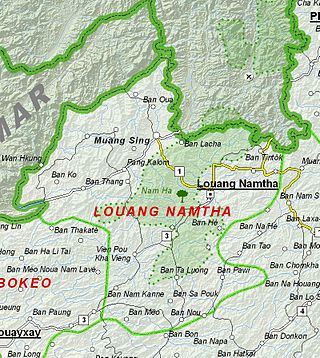
Luang Namtha is a province of Laos in the country's north. From 1966 to 1976 it formed, together with Bokeo, the province of Houakhong. Luang Namtha province covers an area of 9,325 square kilometres (3,600 sq mi). Its provincial capital is Luang Namtha. The province borders Yunnan, China to the north, Oudomxai province to the east and southeast, Bokeo province to the southwest, and Shan State, Myanmar to the northwest.

Sainyabuli province is a province in northwest Laos. Saiyabuli town is the capital of the province. Saiyabuli is the only Lao province that is completely west of the Mekong River.
Operation Maharat was a military offensive of the Royal Lao Government aimed at Communist insurrectionists. At stake was the sole road junction in northern Laos well in the rear of Royalist troops fighting in Campaign Z. On 30 December 1971, the garrison of a Royal Lao Army artillery battery and two Forces Armées Neutralistes battalions was besieged by an attacking force of Pathet Lao and Patriotic Neutralists. On 21 January 1972, the Royalists were reinforced by 11th Brigade, then overrun. The Communists spread north and south along Route 13 over a 110 km (68 mi) stretch. A Royalist counter-attack on 16 March 1972 would find both Route 13 and the intersection vacated.

The Boten–Vientiane railway is the Lao section of the Laos–China Railway (LCR), running between the capital Vientiane and the northern town of Boten on the border with Yunnan, China. The line was officially opened on 3 December 2021.
The Vientiane–Vũng Áng railway is a proposed 1,435 mmstandard gauge railway that ran for 555 kilometres (345 mi) between the capital of Laos, Vientiane, and port in Hà Tĩnh Province via Mụ Giạ Pass on the border between Laos and Vietnam.

The Vientiane–Boten Expressway is a partially completed expressway between Boten, on the China–Laos border, and Vientiane, the capital of Laos. It roughly parallels Route 13.

Route 7 of Laos, ເສັ້ນ ທາງ ເລກ 7 ຂອງປະເທດລາວ (ທ. 7) is a provincial road served from east to west in Xiangkhouang province, Laos. It runs from Nong Het in the east to Phoukhoune District in the west. This is where people change connections to go to Luang prabang or Vientiane.

Vientiane railway station is a railway station in Vientiane, Laos. It is the second station on the Boten–Vientiane railway. The largest and most important station on the line, the station was opened along with the rest of the line on 3 December 2021.
